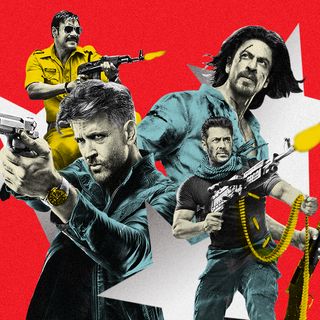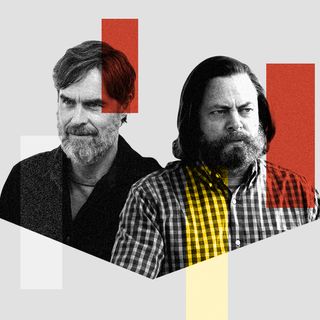
‘The Last of Us’ Is a Timely Reminder to Ask Ourselves: How Far Can We Go to Survive?
Kathleen’s liminal status as neither “good” nor “bad” speaks to the post-pandemic reality of today: how ethical is it to survive at any cost?

This article contains spoilers for episode four of ‘The Last of Us.’
In yet another departure from their source material, showrunners Craig Mazin and Neil Druckmann introduced Kathleen (Melanie Lynskey) in episode 4 of The Last of Us—a character with no in-game counterpart. Within the first few minutes of her presence onscreen, we learn three key things about Kathleen: 1) she’s the leader of a militarized group of populists who’ve taken over Kansas City; 2) she’s on the hunt for Henry and Sam Burrell (familiar names from the game); and 3) she wants revenge for her brother’s death. The audience sees all this from Kathleen’s perspective: that of a character we are expected to hate and even kill in the games. Seeing the post-apocalyptic world through Kathleen’s eyes highlights the ambiguity of morality when it comes to survival. We question who the ‘good’ and ‘bad’ guys are – what this even means in the context of a post-apocalyptic dystopia – and the ethics of killing for survival. In other words: morally speaking, how do we make sense of a person who’s neither “good” nor “bad” but merely surviving?
Perspective plays a significant role in our judgment of the characters. The narrative gives Joel and Ellie an unfair advantage—as the protagonists of the story, we subconsciously see them as morally superior to the others, regardless of the truth of their actions. The show provides complexity by expanding on the stories of several side-characters (i.e. Bill and Frank), which goes a long way in bridging the gap left by the game. Kathleen is meant to represent the hunters, the largely nameless and overly aggressive enemies generated for shoot-out sequences in the game. In the show however, the occupants of Kansas City “are just people”, as Joel tells Ellie, led by a woman hardened over time by circumstances and caught in the same cycle of grief and revenge as so many others. By being given a different point of view, the audience are denied the stability and comfort of their virtuous heroes—after all, in another story, Joel and Ellie could have easily been the ‘bad guys’ doing whatever they had to for survival.
Kathleen’s debut in the story introduces a discussion on the virtue and ethics of survival and the underlying thesis of the entire show: “What would you do to ensure the survival of yourself and your loved ones, and when does it stop being worth it?” It’s a question that each character grapples with over the past four episodes of the show, we see a multitude of responses—Tess’ forced detachment, Marlene and the Fireflies’ violent self-righteousness, Bill and Frank’s utopian isolationism, Joel’s ruthless pragmatism, and Ellie’s bravado. They are all trying to survive, but the audience’s limited perspective colors any judgments made on the morality of their actions, especially in an extra-societal situation like a zombie apocalypse. Although an exaggeration, the actions of these characters aren’t unrealistic or unfounded—only exacerbated by a civilization collapsing calamity.
Related on The Swaddle:
Would You Save 1 Life or 5? Worldwide, Cultures Differ on the Trolley Dilemma
There are philosophical implications to these questions. The main one in The Last of Us pertains to utilitarianism versus virtue ethics. Defined as “a theory that focuses on maximizing happiness of the most number of people”, utilitarianism is most commonly explained through the trolley problem. This parable, which presents two less-than-ideal options, is a metaphor for the continued struggle of humanity in the world of The Last of Us—when the survival of the majority is at stake, what’s the value of a young girl’s life? The doctrine of utilitarianism is an approach to normative ethics in which actions are justified by their outcome; morality becomes a matter of consequence rather than the driving factor. The aphorism “The road to hell is paved with good intentions” is particularly poignant in this case—can the actions of FEDRA, the Fireflies, and even Joel and Ellie be considered ‘right’ when the results are gained by violence and death?
By comparison, virtue ethics concentrates on the morality of the person, defined by a combination of developed principles, habits, and communal input. To what extent are the characters in The Last of Us ‘good people,’ by both our standards as the audience and within the universe of the show? Kathleen, for instance, is a leader determined to protect her people (‘good’) but is willing to lie and kill in order to do so (‘bad’). In this universe, where society has collapsed and violence has become the norm, the thought exercises these various philosophies present are taken to their logical extreme – a narrative choice that holds particular resonance for a world grappling with the aftermath of the Covid19 pandemic.
Though the entire plot of HBO’s The Last of Us has an immediate connection with the post-Covid landscape of our times, the question of how far it is ethical to go for survival remains unresolved even in the real world. In times of strife and conflict, the default setting for humankind tends to be utilitarianism – prioritizing maximum output at the cost of the minority. Those deemed not ‘strong enough’ to survive are disregarded and the morals at the heart of modern society are abandoned as trivial and costly. Conversely, those preaching moral supremacy rise in response, disavowing the difficult choices needed in extreme situations. The Last of Us and its characters hold a mirror up to how we view ourselves, our existing relationship with morality and survival, and ask the question: “How far would you go?”
Akankshya Bahinipaty writes about the intersection of gender, queerness, and race, especially in the South Asian context. Her background in political science and communication have shaped her past multimedia and broadcasting experience, and also her interest in current events.
Related


Woe Is Me! “I’m Not Good at What I Studied. Is it Too Late to Switch Careers?”
